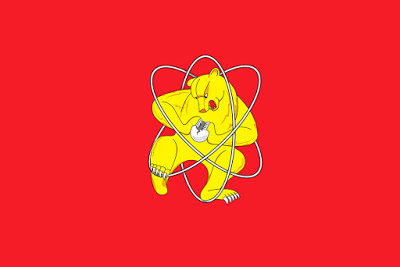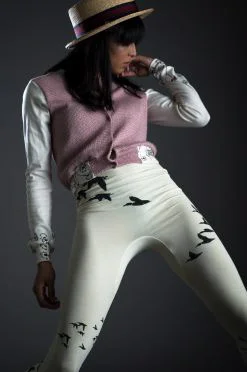(Eerste publicatie: 28-10-2013)
Ik heb al eens iets geschreven over een paar prachtige Russische stads- en provincievlaggen. Over die van Magnitogorsk bijvoorbeeld (zie nummer 2 op het lijstje hieronder), waarbij je de neiging krijgt om op het zwarte driehoekje te drukken en dat er dan een filmpje begint.
Het zwarte driehoek is het symbool van ijzererts. De aanwezigheid van die delfstof was in 1929 de reden voor de stichting van de stad.
En ik had het idee om een verzamelingetje aan te leggen van dat soort vlaggen en er dan een stukje over te schrijven. Maar dat hoeft niet meer – het is al voor me gedaan, en nog in een aardige vorm ook: een kleine quiz. Bestaan de vlaggen hieronder echt of zijn ze verzonnen? Ik vond de quiz hier, ik neem hem in z’n geheel over, inclusief de Engelse onderschriften. Helemaal onderaan staan de antwoorden. Die van Magnitogorsk had ik (en u nu ook) natuurlijk goed. Ik herkende er nog drie, de rest heb ik gegokt. Mijn score: tien goed!
1. Pskov. In western Russia’s version of the Sistine Chapel, God’s hand extends from its ruffled cloud-sleeve in order to pat a prancing leopard on the stomach.
2. Magnitogorsk. The avant-garde legacy of Malevich’s Black Square meets the industrial might of Stalin’s Soviet Union in this exquisitely severe flag, which represents the mountain of pure iron ore that first lured metalheads to this distant outpost.
3. Sjimanovsk. Train tracks (not ladders!) mean everything to the Far Eastern town of Shimanovsk, which was founded when the Amur railway rolled by in 1910. So they put them on their flag.
4. Tsjeljabinsk (regio). Nature’s least cuddly and most thick-skinned beast is a surprisingly fitting symbol for the unlovely Chelyabinsk Region, capturing as it does the unique charms of this heavily polluted corner of the Urals.
5. Anadyr. In Russia’s toxic political climate it is heartening to see a flag that celebrates the tender, non-traditional love of a smiley bear and a fish. Well done, Anadyr, an oasis of tolerance in distant Chukotka.
6. Penza (regio). The wide availability of Photoshop has transformed the world of flag-making, for instance empowering the pious people of Penza to marry an ancient icon and an 8-bit lemon’n’lime palette to create a spooky floating Jesus-head.
7. Mirny. The Siberian town of Mirny is famed, above all, for the enormous hole that lurks outside the city. The big pit does have a purpose though: it is, or was, full of sparkly diamonds. But, having seen the flag, you already knew that.
8. Zjeleznogorsk. Why is that angry hula-hooping bear trying to peel that enormous hard-boiled egg? Because he’s the symbol of Zheleznogorsk, a closed Siberian city founded in 1950 to develop weapons-grade plutonium and, it seems, to train super-strong bears to physically rip atoms apart.
9. Moemra. The marvellously named Mumra is famed for its high-quality ball-bearings. Not really: these gorgeous globules are actually caviar, served heraldry style, in honour of the Caspian town's major export. And that's their doting mother sturgeon in the corner.
10. Irkoetsk. This is what Mondrian’s nightmares looked like. Nice geometrical shapes, strong primary colours, and a terrifying black tiger devouring a bright red sable. Although, frankly, the beady-eyed predator looks more frightened than anyone.
11. Sjoeja. Another strong geometrical entry. That comely cuboid, glistening like an individually wrapped butter portion, actually symbolises a bar of soap. Obviously. Back in the 18th century the tiny town of Shuya grew filthy rich on filthy Russians and wasn’t shy about advertising the fact.
12. Komsomolsk aan de Amoer. Komsomolsk-on-Amur was built by the volunteer labour of young communists. If this jaunty chap is anything to go by, they had a whale of a time.
13. Kimoski (district). A pleasing fusion of the Iraqi flag and a tie-dye-wearing teenager’s poster collection. Yes, that’s right, those are three cannabis plants. Back in the 18th century, this area near Tula was Russia's golden triangle of dope production.
14. Tsjeljabinsk. Even more powerful than the flaming space-rock itself was the wave of comet-fever that hit Chelyabinsk this year. The delirious citizens even went so far as to put it front and centre on the city flag.
-----------------------------------
De volgende vlaggen zijn verzinsels: 3, 7, 9 en 14. Dit zijn de echte:
3. Sjimanovsk. Shimanovsk would never be content with such a drab flag. This, according to Wikipedia, is their coat of arms.
7. Mirny. Those boring bureaucrats at Mirny town hall wouldn't know their elbows from their vast holes. This is the real one.
9. Moemra. Don't be ridiculous: Mumra doesn't have a flag. But you can find a crest for the surrounding region that's ripe with potential.
14. Tsjeljabinsk. Sanity has prevailed and they've stuck with the noble and implacable camel, this time posing in front of a wall.
Over de vlag van Anadyr (nummer 5) wordt nog gezegd: ... our interpretation of the symbolism may not be canonical.





















